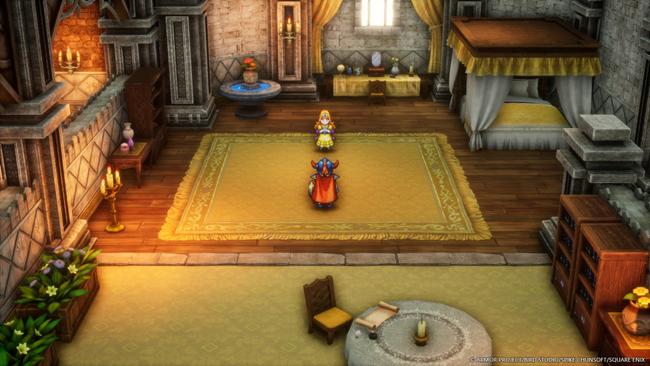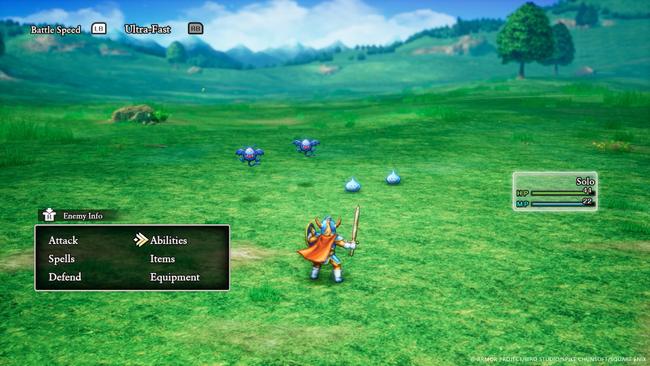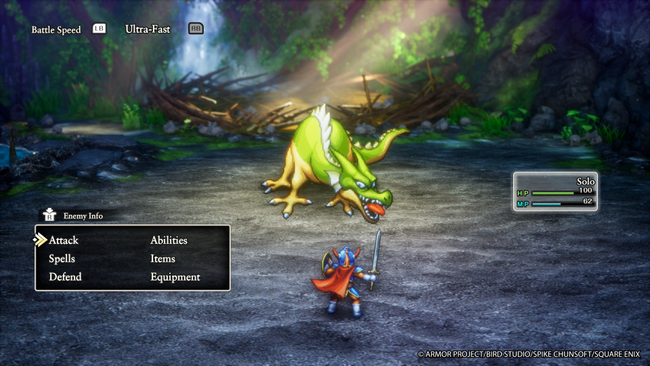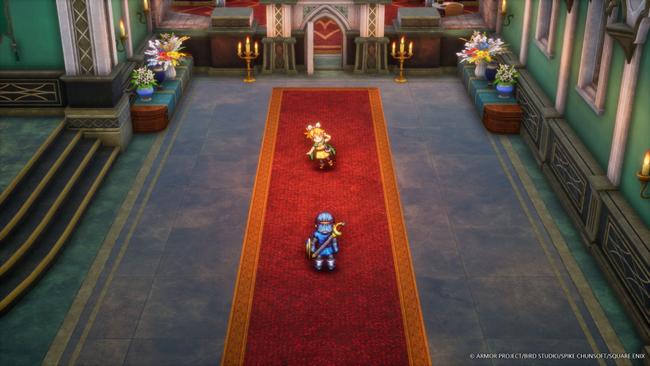
Dragon Quest I & II HD-2D Remake Review
Defining what truly makes a “classic Dragon Quest” is tricky. Every mainline Dragon Quest builds off the entries that came before in some substantial way, so where does Classic start and Modern begin? In this era of remakes, how could you even properly revisit the old games? For last year’s Dragon Quest III HD-2D Remake, Square Enix clearly felt that the game didn’t need much. It’s a landmark title for a reason, so a new coat of paint (and some rebalancing) was almost perfect for it. For Dragon Quest I & II HD-2D Remake, however, they clearly felt the need to put a lot more thought into how to approach a remake.
These are not faithful remakes of Dragon Quest and Dragon Quest II, but instead new interpretations - more so than with Dragon Quest III. Whether the idea was not to make another straightforward port this time (I count ten different versions of I and II that have been made since they first released about 40 years ago. Do you feel old yet?), or they felt like the games were too archaic to be enjoyed by modern audiences, I can’t really say. I adore the first two Dragon Quest games, even more than the much more iconic third entry. Dragon Quest I is a tightly designed, short & sweet RPG that knows exactly how best to use the limitations of the hardware to its advantage. Dragon Quest II is the sequel that strived for more than it could meaningfully handle.

Dragon Quest I and II each feature the lineage of the Erdrick, the hero of Dragon Quest III, who settled into Alefgard after his way home was sealed away. The first title involves a solo adventurer getting called by a mysterious voice to rid the world of the villainous Dragonlord. The second involves his family line ages later, a group of royal cousins having to stop the rise of a wizard named Hargon. Now that the original twist of Dragon Quest III has been so thoroughly established, the goal of these remakes is for I&II to properly serve as sequels this time around.
I’ll refer back to my review of the III HD-2D Remake regarding the moment-to-moment gameplay. There’s actually a lot carried over from the foundation of last year’s remake, from the flow of battles to dungeon and overworld traversal. In your time roaming the land of Alefgard, you’ll go from town to town helping people in need and resolving little story arcs along the way. How they use that foundation varies wildly in both of these remakes, but interacting with the game world is more or less the same. The new flourishes to exploration, like brilliant interior design for buildings and secret spots, also return. If you played the previous remake, you’ll feel right at home.
It is worth serious praise to say that both of these games are now much harder than Dragon Quest III HD-2D was. When played in the new intended chronological order (III->I->II), you get a more gradual climb in difficulty, which also helps ramp the stakes up from entry to entry. As you dive deeper into the endgame of these two titles, enemies hit harder, and bosses are far deadlier. When you get to the point of fighting Hargon’s main lackeys at the end of II, you feel like these are challenges that the III Hero wouldn’t even be able to handle. It’s always nice to play a modern RPG with some actual bite to it, and I think I got full party wipes more times than I could keep track of during the second halves of both games.

The biggest change to combat is the introduction of Sigils, which can augment certain abilities under specific circumstances for each character. An example would be that if your character is about to die, you can hold the left face button when hovering over a certain spell or ability. You could maybe enhance your Dragon Slash for your Hero into a Double Dragon Slash, but at the cost of more MP. If you don’t have the MP to use the powered-up skill, you waste your turn. I quite enjoy how this almost encourages you to play dangerously and take more risks, but also punishes you for blindly using it.
Alternatively, if a character takes a particularly devastating attack but lives, and you happened to already select a skill you can power up, you can hold the left face button before the action is cast to power it up in real time. This right here is probably the most interesting addition to Dragon Quest combat in years, making it more active in minor ways while keeping the core combat that’s crucial to the charm. These games don’t see massive changes from title to title, so I hope this is a hint at some more innovations coming for the series’ tried and true battle system.
Dragon Quest II’s defined characters and the remake’s higher challenge lead to some wonderful moments that you just wouldn’t get with how things needed to be handled in III’s customizable party. In addition to the prince and princess of Cannock and Moonbrooke (respectively), you have the princess of Cannock joining you in this remake, and honestly, it felt like a seamless addition. Her role is to be a jack of all trades, master of none. She can deal decent damage, cast spells, with the only real boon she has over the other party members being her speed.

I found bosses to be pushovers in III's remake, likely because they needed to be handled to accommodate multiple different party combinations. In II, they know exactly what kind of party you’ll have and can design the challenge exactly around that for bosses. While this might not make the games as replayable, I think they better serve the first-time playthroughs much stronger by being more tightly designed. This is the same with the Dragon Quest I hero, who has an expanded arsenal to handle bosses who put much more pressure on you than ever before. The boss battles in both games in this are some of the best I’ve played in the series.
What’s more interesting is how the team remaking these Dragon Quest games has redesigned how progression works. The entire original Dragon Quest had one guy walking through a continent, killing monsters one-on-one, talking to townsfolk to vaguely figure out where to go. This makes progression obtuse, but forcing players to engage with the world and talk to NPCs is a great way to get them engaged with the setting. All of the early Dragon Quest games specialize in this, as Yuji Horii used his experience making adventure games (like The Portopia Serial Murder Case) to make solving where to go and what to do feel like investigating a mystery.
This remake of DQ I is a lot more linear, breaking up your goals into explicit main story quest-like arcs with a significantly higher volume of cutscenes. For most people, this will be great, especially if they never really clicked with the original game. While I think many of the additions feel like overexplaining events that I originally appreciated piecing together myself, some of the new cutscenes do just feel like overall improvements. Princess Gwaelin has more agency, having her role change from just a damsel you can optionally save to someone actively holding back the forces of the Dragonlord.

In making all these smaller moments mandatory, I do think it does wonders for the story. You have a cast of characters that contribute to Alefgard feeling real, making the threat of the Dragonlord feel tangible. I wouldn’t say any of the new characters are especially memorable, but seeing them struggle and barely hold their own against the Dragonlord gives the conflict stakes that it just didn’t have before. The faeries are probably the highlight of this, especially the ones that carry over into Dragon Quest II, with their story arc feeling the most poignant of all of the new ones in the game.
However, in trying so hard to expand and flesh out this first game, it makes it feel small. It feels less open, even with objective markers turned off. You feel railroaded from moment to moment, especially in the endgame, where you’re jumping around to places you’ve already been to as you get the last of the plot-important items to go fight the final boss. I like this remake of Dragon Quest I a lot, but I couldn’t help but feel like something was lost by not keeping it as open-ended as it was before. The minimalist storytelling brought the game design to the forefront, which is no longer the case. Not too much was lost from the core experience, and many things were even gained, but I think overall this remake overstays its welcome with how much the story was expanded.
The intended experience with this remade trilogy is to play the games chronologically, or in the new release order. With III’s once-twist reveal of being a prequel now an open secret, the team remaking this trilogy decided to rework the games to follow one continuous, linear narrative. While the original games are best enjoyed going from I to II to III, the intended experience with these particular remakes is III to I to II. This sets up II as an explicit conclusion to the Erdrick Trilogy, so they had to bring their A-game to uplift the original game into something it was never trying to do.

Last year, I had the hope that III HD-2D’s minor changes and story expansions would be a good sign for what would come from this team working on a remake of Dragon Quest II. My expectations were not set properly for the Dragon Quest game that was awaiting me with this new version of II. I’ve always had a sweet spot for how Dragon Quest II established most of the Dragon Quest formula, but playing it was a different story. The original DQ2 was unfocused, grindy, and just too ambitious for its own good. This kind of game is all too common in this era of franchises being born out of nothing. I find DQ2 to be a better game than many “black sheep” entries, but it definitely is a game that was trying to do too much within its own scope.
This is no longer a problem with this new remake. I spent 50 hours with this new Dragon Quest II, something I’d have never expected in a million years. Somehow, I never felt like that time was wasted, which is even more shocking given how light a game it was expanding on. They’ve done this by fleshing out both the story and the exploration to match the scale of later Dragon Quest games. It’s great that we have a whole undersea version of the map to explore, but I think fleshing out the cousins into full-on characters was brilliant.
While DQ I’s story additions feel out of place at parts, by just giving the cousins more to say for themselves, any possible bloat the expanded cutscenes could have added is gone. Each of the cousins is a fleshed-out character that goes through their own character arcs, and they always have something to say about every scene, and feel like active participants now in a way they just didn’t before.

The Cannock siblings are charming, being high-energy characters that often bring levity to scenes when needed. While the Prince isn’t as iconically pathetic as he was before, he has been reworked to be the best pal of the group. His sister has something to prove, being not officially invited to the group, but her spunky energy matches the new takes on the rest of the scions of Erdrick. The princess of Moonbrooke especially steals the show, with the new writers expanding her background of having her entire village destroyed into a proper character arc of her working through her need for revenge. She is practically the main character now, but that doesn’t mean our silent protagonist is devoid of an arc himself.
It is established early on that his inability to cast magic (The Dragon Quest II hero has always been your physical damage dealer) is something widely known in his kingdom, something that does seem to bother him. In one of my favorite moments in the game, after many hours of your main group of royal misfits being the only ones to be able to solve the world's problems, you come across a quest where a young knight in Cantlin seeks out heroes to deliver them a key item.
He sends you on a bit of a wild goose chase, but reveals that his motivation was a need to prove himself. You see, he feels inadequate as a knight, unable to use magic. This, of course, draws the connection to your protagonist, inspiring this character with the knowledge that lineage is not what makes the heroes go out to save the world. Anyone could do it, and should make an effort to fight back against Hargon. There are so many little moments like this added to the story now, feeling like the well-rounded vignette storytelling you’d really only see from the games that came after the original Dragon Quest III. Every town you visit has a story to tell, and they all range from solid to great. I got misty-eyed quite a few times

Despite being 30 hours longer, I felt Dragon Quest II was a much better-paced game than the first game. The moment you get your boat, the adventure becomes entirely your own. You decide where to go, exploring the open sea and finding people around the world to help as you go. The boat being introduced in this game originally is one of the reasons I’ve always been fond of it, because this moment in every subsequent Dragon Quest represents true freedom. With the remake refining and conveying your objectives to you, yet not always pointing you in the exact direction on how to find them, it preserves the original intent and enhances it substantially with clever storytelling. This game has become a grand epic, wrapping up all of the dangling plot threads established from the beginning of this remade trilogy.
Dragon Quest I & II HD-2D feels like the main course of this Erdrick Remake Trilogy. You can tell the development felt there was a lot of untapped potential for this setting. While I don’t think the remakes exist as complete replacements of the originals, they’re fascinating re-imaginings that strive to uplift the original material. This is the most interesting kind of remake we can get from a game, because there’s so much to chew on.
I might not have liked everything they did with Dragon Quest I here, but it got me to reflect on what parts of Dragon Quest I found special to me. In Dragon Quest II, a game I originally respected but didn’t really enjoy as much, it got me to reflect on what I value from this entire franchise. Dragon Quest II was the perfect playground for this team to take the lessons learned from the pacing and storytelling of nine other Dragon Quest games and apply them to a game that always felt lacking. It manages to elevate so much of the original II and turn it into one of my new favorite games in the series. It’s a crowning achievement, and anyone who enjoys classical turn-based RPGs should give DQII its flowers now.